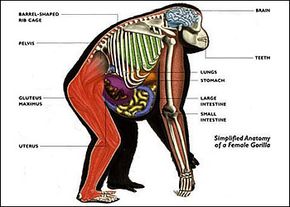Quck answer
Female gorillas have similar anatomy to human females. They have a pelvis, reproductive organs, mammary glands, and a uterus. However, there are some differences between the two species. Female gorillas have a larger pelvis and a longer birth canal to accommodate their larger offspring. They also have a smaller reproductive tract and a less prominent clitoris. The mammary glands of female gorillas are located on their chest, and they produce milk for their offspring. Overall, the anatomy of female gorillas is adapted to their unique reproductive and maternal needs.
Wild Animals

Simplified Anatomy of a Female Gorilla
DCI
Similar to other mammals, the female gorilla possesses four limbs and a robust skull to safeguard its large brain. Additionally, its thoracic cavity holds a four-chambered heart and a pair of lungs.
– Brain
The gorilla’s brain is comparatively larger and more complex than that of less developed mammals.
– Teeth
The gorilla’s sharpened canines and incisors work as shearing blades when it feeds on ground plants.
– Pelvis
The female gorilla’s pelvis provides a surface for the attachment of the powerful muscles that support its heavy, stooped torso.
– Gluetus Maximus
The gorilla’s underdeveloped buttocks muscles (in comparison to humans) cause its bipedal motion to be a shuffle.
– Uterus
In contrast to the uteri of many other mammal species, this gorilla’s uterus lacks horns and contains a single fetus that is nearing the end of its gestation period.
FAQ
1. What is the average weight of a female gorilla?
The average weight of a female gorilla is around 200-250 pounds, with some individuals weighing up to 300 pounds. This is significantly less than the weight of a male gorilla, which can weigh up to 400-500 pounds.
2. What is the lifespan of a female gorilla?
Female gorillas can live up to 35-40 years in the wild, and up to 50 years in captivity. However, their lifespan can vary depending on various factors such as habitat, food availability, and disease.
3. How do female gorillas differ from males?
Female gorillas are generally smaller and lighter than males, with shorter arm spans and less pronounced cranial crests. Unlike males, they do not develop silver hair on their backs as they age.
4. What is the reproductive cycle of a female gorilla?
Female gorillas reach sexual maturity at around 7-8 years old and have a menstrual cycle that lasts 28-30 days. They typically give birth to their first offspring at around 10-12 years old and have an interbirth interval of around 4 years.
5. What is the gestation period of a female gorilla?
The gestation period of a female gorilla is around 8.5 months, similar to that of humans. They typically give birth to a single offspring, although twins are rare.
6. How do female gorillas care for their young?
Female gorillas are very attentive mothers and care for their young extensively. They carry their infants on their chests for the first few months of life and nurse them for up to 3-4 years. They also teach their offspring important skills such as climbing and foraging.
7. What is the diet of a female gorilla?
Female gorillas are primarily herbivores and consume a wide variety of vegetation, including leaves, fruits, and shoots. They may also eat insects and occasionally small animals.
8. How do female gorillas communicate?
Female gorillas communicate using a variety of vocalizations, including grunts, screams, and hoots. They also use body language such as facial expressions and gestures to convey their emotions and intentions.





Leave a Reply